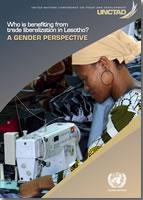
Though important gender gaps persist in a number of critical areas, the experience of Lesotho highlights that the political resolve to promote gender equality is not, and should not be, a monopoly of high-income countries.
Even those countries qualified as least developed countries (LDCs) can ambitiously adopt and implement strategies and policies aimed at reducing gender-based disparities.
The Lesotho case study highlights the multifaceted relationship between trade policy on the one hand, structural changes and productive transformation on the other, and their repercussions on patterns of employment for men and women.
In particular, the rise – and subsequent relative decline – of Lesotho as a major apparel exporter to the United States illustrates clearly the strong correlation between trade policy, structural change in the economy, and shifting gender patterns.
This report aims to critically assess the gender implications of Lesotho’s trade-led productive transformation.
The study is structured as follows:
-
Chapter 1 provides a broad country overview.
-
Chapter 2 assesses the gender situation in Lesotho, by considering both gender-related “outcomes” (the relative position of men and women in key aspects of social life) and relevant policies and social institutions (“input” or “means” variables).
-
Chapter 3 reviews some changes in Lesotho’s structure of production and trade, outlines some underlying trade policy developments, and singles out some gendered implications of these developments.
-
Chapter 4 closes with some summary observations and illustrates a spectrum of policy options for Lesotho for the implementation of a gender-sensitive trade strategy.


